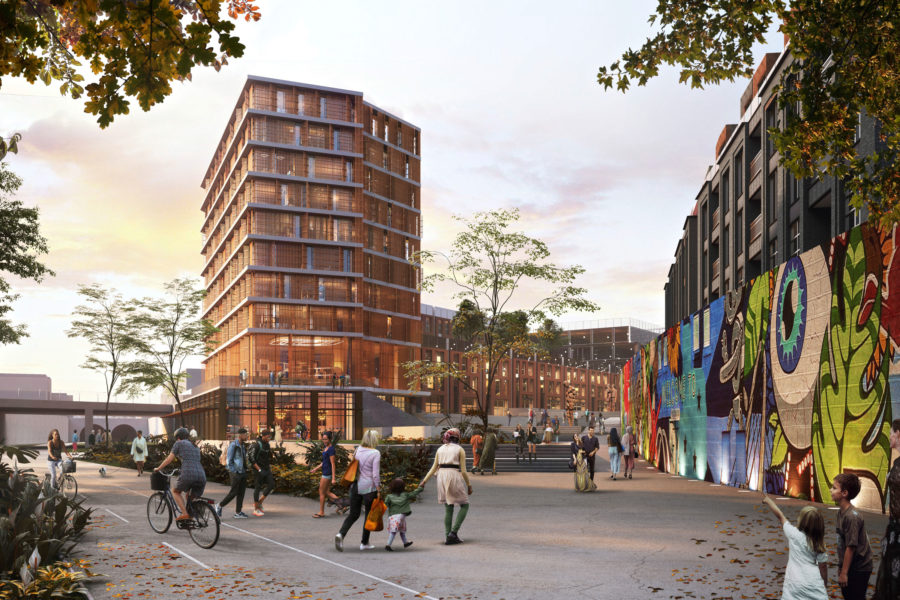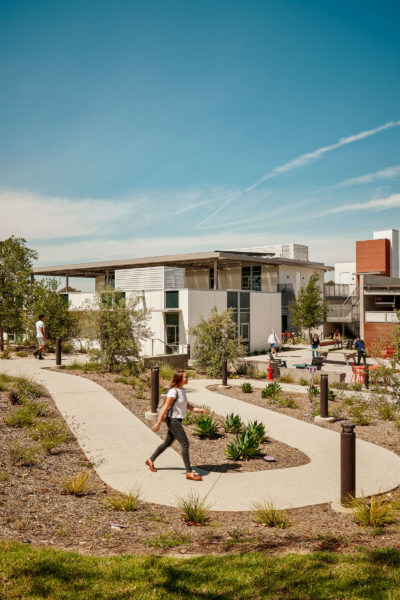Story at a glance:
- Gensler is weighing the benefits of a reduced carbon footprint versus social inequity.
- Design leaders are looking at how to design more inclusive neighborhoods.
- What is really the best kind of green space, and what makes a place walkable?
Live, work, play—the concept of the “20-minute city,” or neighborhoods where everything you need is steps from your door, continues to gain traction across the US.
While the benefits of such urban planning are many, it doesn’t go far enough to address inequities, according to Stacey Olson, Gensler’s global design resilience leader, who writes about the topic on Gensler’s blog. She says dense, urban communities reduce greenhouse gas emissions by encouraging people to walk and bike, but even though these communities may reduce a city’s carbon footprint, they often spread social inequalities and create niches that lack diversity.
In Detroit, Gensler is working on a mixed-use development called Infill on the Cut that will encompass 350 residential units, 80,000 square feet of retail, and 18,000 square feet of green space. Once implemented, the master plan of this project will bridge the gap between downtown Detroit and the neighborhoods surrounding Eastern Market by creating exciting, beautiful places to live, shop, and play. The plan arranges multiple residential unit types, hyper-local retail uses, neighborhood-serving amenities, and potential hospitality use around a dynamic public space. The design of the project leverages adjacency to the Dequindre Cut—a rail-to-trail greenway conversion to provide future residents and visitors access to an open-space network connecting two of the region’s most cherished assets (the Eastern Market district and the Detroit Riverfront).
We talked with Olson about the future of walkable communities—and what that means for social equity.
What drew you to the 20-minute city concept?

The Infill on The Cut is a development in Detroit that will challenge the conventional mixed-use approach and create a new gateway to downtown that is inclusive, welcoming, and equitably prosperous. Rendering courtesy of Gensler
I’ve been doing some personal research about designing for an equitable future that looks at economy and resiliency, sustainability, health and wellness, and how all of those things really lead to potential for the 20-minute city. When I started going down this rabbit hole, there were some gaps in the 20-minute city. We can design for those, but it has to be thoughtfully designed for. The 20-minute city in and of itself doesn’t check all of the boxes for all of the things we should be doing. So that’s where my passion was: How do I marry all of the things I’m doing with health and wellness? We want to be inclusive.
How is the concept currently flawed?
My original hypothesis was, “The 20-minute city is great.” We’ve been talking about it for a long time—how this will help people be active and help create resilient communities. The more I researched it, there’s a substantial body of evidence in academic white papers and third-party peer-reviewed studies and an analysis that shows that, yes, the 20-minute city can be great, but it can also isolate folks.
If you have, for example, all of the things you need within your community that’s great, but how many jobs does that provide for? Especially low income jobs. If you’ve got a population who lives in a 20-minute city and there’s not a job market for them, then they’ve been excluded from that city. That’s really when we start to think about transit-oriented development.
Why is transit-oriented development important?
When you have a 20-minute city that is connected to a transit-oriented development, then you can start to get those people mobile. You have to think about mobility. Can people move around and get outside of the city and connect to their hubs?
The other side of that is accessibility. Do they have access to the means to travel? Even if you pair the TOD with the 20-minute city, neither of those fully address resiliency. So you need to start extrapolating: If we can make the 20-minute city connected to mass transit—essentially off the grid, decentralized—then you start to be able to conserve your resources and create different kinds of jobs because you bring the utilities and there are higher grade jobs. It starts to become much more resilient bringing all those things together.
What about walkability? What makes a city walkable?
In order to encourage walkability, people need to have a reason to get outside and go somewhere, to walk. You really want to have a variety of mixed uses. Not everyone’s going to want to go to the same place, so having that rich diversity, whether it’s amenities or open space, you need to have safe spaces to walk and a wide enough sidewalk and protection from the elements. For example, you don’t see people in desert conditions going outside when it’s 105 degrees. So how do we mitigate temperature?
What is the best kind of green space?

Outside of the Hillside Housing Admin Office at CSULB. Photo courtesy of Gensler
One of the things we don’t really talk a lot about is the importance of soil in the conversation for climate change. Soil has a huge capacity for absorbing and really sequestering CO2 emissions. The more green space we have the better. We don’t want to pave over paradise. But that said, we have to get away from this idea that monoculture is beautiful, like just grass or lawns. It’s great to have a field where you can take a blanket and have a picnic, but the idea that we need to have just open green space as a lawn we need to move away from. We have to celebrate diversity, and in the end that’s really going to look different in every climate.
We just did a really great project at Cal State Long Beach (CSULB). The project is pursuing Living Building Challenge LEED Platinum certification, and we had a really rich biodiversity plan for the landscape. When the project was finished we were looking around and, all of a sudden, there was a bunny rabbit. Bunny rabbits, hummingbirds, butterflies, and all sorts of nature showed up. We can really start to make a site really feel special. We can bring all of this back.
What are some common mistakes in today’s designs?
I think if we can shift the way planning approvals are done, that could be a real game changer. When we think about planning approval, it would be ideal if planning approvals were really thought about holistically as integrated systems, not as ‘This is a residential development’ or ‘This is a mixed use development,’ or ‘This is a TOD’ and then mechanical, electrical, plumbing. If it was brought on as a holistic approach where the entire development had to have all of these things—has to have a certain amount of low income housing, a certain percentage of mass transit—if those were fundamental requirements in order to go through the planning approval process, that could be a real game changer for making sure we don’t inadvertently exclude any population.
Why isn’t that the requirement?
We’ve been doing some research on this. There have been instigators in the urban planning department world. And there have been lots of studies arguing that this industry is ripe for a shakeup. I think one of the challenges is that there is a whole sector of urban planning officials who don’t know that this is a problem. If you’re not realizing that as a problem, it’s hard to create change that’s prolific throughout the industry.




